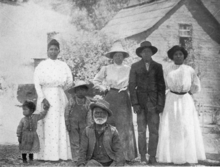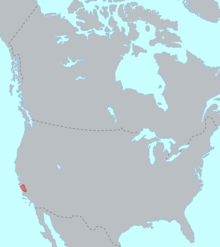The Salinan are a Native American tribe whose ancestral territory is in the southern Salinas Valley and the Santa Lucia Range in the Central Coast of California. Today, the Salinan governments are now working toward federal tribal recognition from the Bureau of Indian Affairs.
Te'po'ta'ahl | |
|---|---|
 Miguelino family near Mission San Antonio de Padua | |
| Total population | |
| 681 (2000, census) | |
| Regions with significant populations | |
| Languages | |
| English, formerly Salinan | |
| Religion | |
| Salinan traditional narratives |


Geographic origins
editThere were two major divisions and one subgroup. From north to south, the Antoniano lived in the lower part of the Salinas Valley (which flows south to north), near the future site of two missions: (Mission San Antonio de Padua and Mission San Miguel Arcángel). The Miguelino lived on the upper course of the Salinas River, and to the south near Slates Hot Springs, Junipero Serra Peak, and Soledad. There were also a Playano subgroup on the Pacific Coast in the vicinity of what is now Lucia and San Simeon. Salinans were Hunter-gatherers and, like most other California tribes, were organized in small groups with little centralized political structure.
They left shell middens behind indicating that they lived in the area in numbers along the coast. Their main diet during the summer consisted of fish and shellfish, evidenced by the fine particles of shell present in the soil for a depth of several feet in areas where the Indians camped. The Salinan named the peak Pimkolam.[1][2]
The 56 acres (23 ha) Wagon Caves rock formation about 18 miles (29 km) northwest of present-day Jolon is an archeological site that was used by the Salinan Antonianos subtribe[3][4] who researchers believe occupied at least two villages in the area, an older site dating to approximately 450 A.D. and a later, protohistoric site with dates ranging from about 1450 to 1650 A.D. Archeologists have found a stemmed biface, lithic flakes, shell beads, and non-human bones, as well as shell, bone, flaked stone, fire-affected rock, charred seeds, and mortars at the cave site.[5] The rock overhangs and caves have fire-scarred roofs that bear evidence of occupancy over hundreds of years. The Wagon Cave Research Natural Area of 806 acres (326 ha) contains diverse stands of Valley Oaks of varying ages and densities and has been recommended as a Research Natural Areas within the Los Padres National Forest.[6]
Etymology
editThe tribe's name is taken from the Salinas River, as the Spanish did not understand if the people had a name for themselves.[7][8] The people's own name is "Te'po'ta'ahl" or "People of the Oaks," according to current tribal leadership.[9] C. Hart Merriam called these people the En-'ne-sen on advice from one informant; En-'ne-sen was the native word for the Salinan headquarters.[10]
Language
editThe Salinan language, spoken until the 1950s[11] is a language isolate. It may be a part of the Hokan language family. Sapir included it in a subfamily of Hokan, along with Chumash and Seri; this classification has found its way into more recent encyclopedias and presentations of language families, but serious supporting evidence has never been presented.[12]
Population
editEstimates for the pre-contact populations of most native groups in California have varied substantially. Alfred L. Kroeber put the 1770 population of the Salinan as 3,000.[13] Sherburne F. Cook similarly estimated that there were at least 700 Salinans.[14] The 2000 United States Census reported a total population of Salinan people as 681.[15]
See also
editNotes
edit- ^ Jewell, Jennifer (October 12, 2018). "Obi Kaufmann & The California Field Atlas; Botanical Artistry Of October, Part 2". Cultivating Place (Podcast). North State Public Radio. Retrieved February 13, 2019 – via SoundCloud.
- ^ Kaufmann, Obi (2017a). The California Field Atlas. Heyday Books. ISBN 978-1-59714-402-5.
- ^ Clearinghouse, Passport in Time. "Wagon Cave". Passport in Time. Retrieved 31 March 2022.
- ^ "Monterey County Historical Society, Local History Pages--Overview of Post-Hispanic Monterey County History". www.mchsmuseum.com. Archived from the original on 22 May 2006. Retrieved 17 March 2022.
- ^ Cummings, Linda Scott; Puseman, Kathryn; Dexter, Jaime; Eksambekar, Sanjay (2005). "POLLEN, PHYTOLlTH, AND MACROFLORAL ANALYSIS AT SITE CA-MNT-307, CALIFORNIA". Retrieved 2 April 2022.
- ^ "Wagon Caves" (PDF). www.fs.fed.us. Retrieved 31 March 2022.
- ^ Clearinghouse, Passport in Time. "Wagon Cave". Passport in Time. Archived from the original on 17 April 2022. Retrieved 31 March 2022.
- ^ Mason, J. Alden (1856). "The Ethnology of the Salinan Indians" (PDF).
- ^ Eargle, Dolan H. Jr (5 January 2007). Dodsworth, Fred (ed.). Native California: An Introductory Guide to the Original Peoples from Earliest to Modern Times. Trees Co Pr. ISBN 978-0-937401-11-8.
- ^ Hester, p.504
- ^ "Salinan Language and the Salinan Indian Tribe (Sextapay, Antoniano, Migueleno)". Native-languages.org. Retrieved 13 October 2017.
- ^ Marlett 2008
- ^ Kroeber, p.883
- ^ Cook, p.187
- ^ "Census 2000 PHC-T-18. American Indian and Alaska Native Tribes in the United States: 2000" (PDF). September 2002.
References
edit- Campbell, Lyle (1997). American Indian languages: the historical linguistics of Native America. Oxford: Oxford University Press.
- Cook, Sherburne F. 1976. The Conflict between the California Indian and White Civilization. Berkeley, California: University of California Press.
- Kroeber, Alfred L. 1925. Handbook of the Indians of California. Bureau of American Ethnology Bulletin No. 78. Washington, D.C.
- Hester, Thomas R. 1978. Salinan, in Handbook of North American Indians, vol. 8 (California). William C. Sturtevant, and Robert F. Heizer, eds. Washington, DC: Smithsonian Institution, 1978. ISBN 0-16-004578-9 / 0160045754, pages 500–504.
- Marlett, Stephen A. 2008. The Seri-Salinan connection revisited. International Journal of American Linguistics 74.3:393-399.
- Sapir, Edward. 1925. The Hokan affinity of Subtiaba in Nicaragua. American Anthropologist 27: (3).402-34, (4).491-527.
- National Public Radio segment by Allison Herrera, December 13, 2017